| Listing 1 - 5 of 5 |
Sort by
|
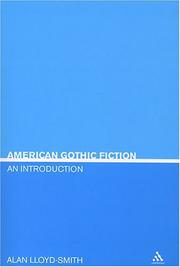
ISBN: 0826415954 0826415946 9786613207654 1441190449 1283207656 9781441190444 9781283207652 9780826415950 9780826415943 Year: 2004 Publisher: New York Continuum
Abstract | Keywords | Export | Availability | Bookmark
 Loading...
Loading...Choose an application
- Reference Manager
- EndNote
- RefWorks (Direct export to RefWorks)
Following the structure of other titles in the Continuum Introductions to Literary Genres series, American Gothic Fiction includes: A broad definition of the genre and its essential elements. A timeline of developments within the genre. Critical concerns to bear in mind while reading in the genre. Detailed readings of a range of widely taught texts. In-depth analysis of major themes and issues. Signposts for further study within the genre. A summary of the most important criticism in the field. A glossary of terms. An annotated, critical reading list. This book offers students, writers, and se
American fiction --- Gothic revival (Literature) --- Horror tales, American --- History and criticism. --- History and criticism --- ROMAN AMERICAIN --- NEO-GOTHIQUE (LITTERATURE) --- LITTERATURE D'EPOUVANTE AMERICAINE --- HISTOIRE ET CRITIQUE --- ETATS-UNIS
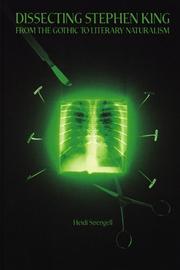
ISBN: 0299209741 9780299209742 0299209733 9786612269851 1282269852 0299209709 9780299209735 9781282269859 6612269855 9780299209704 Year: 2005 Publisher: Madison, Wis. University of Wisconsin Press/Popular Press
Abstract | Keywords | Export | Availability | Bookmark
 Loading...
Loading...Choose an application
- Reference Manager
- EndNote
- RefWorks (Direct export to RefWorks)
Horror tales, American --- Gothic revival (Literature) --- Naturalism in literature. --- History and criticism. --- King, Stephen, --- Criticism and interpretation. --- KING (STEPHEN), 1947 --- -LITTERATURE D'EPOUVANTE AMERICAINE --- NEO-GOTHIQUE (LITTERATURE) --- NATURALISME DANS LA LITTERATURE --- CRITIQUE ET INTERPRETATION --- HISTOIRE ET CRITIQUE --- ETATS-UNIS
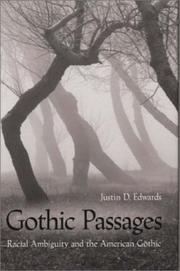
ISBN: 0877458243 9780877458241 1587294206 9781587294204 Year: 2003 Publisher: Iowa City : University of Iowa Press,
Abstract | Keywords | Export | Availability | Bookmark
 Loading...
Loading...Choose an application
- Reference Manager
- EndNote
- RefWorks (Direct export to RefWorks)
This groundbreaking study analyzes the development of American gothic literature alongside nineteenth-century discourses of passing and racial ambiguity.By bringing together these areas of analysis, Justin Edwards considers the following questions. How are the categories of "race" and the rhetoric of racial difference tied to the language of gothicism? What can these discursive ties tell us about a range of social boundaries-gender, sexuality, class, race, etc.-during the nineteenth century? What can the construction and destabilization of these social boundaries tell us
Ambiguity in literature. --- American fiction --- Gothic revival (Literature) --- Horror tales, American --- Passing (Identity) in literature. --- Race in literature. --- Racially mixed people in literature. --- History and criticism. --- Mulattoes in literature --- AMERICAN FICTION --- RACE RELATIONS --- RACE IN LITERATURE --- AMBIGUITE DANS LA LITTERATURE --- NEO-GOTHIQUE (LITTERATURE) --- 19th CENTURY --- U.S. --- ETATS-UNIS --- Multiracial people in literature.
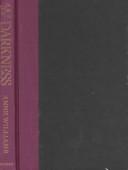
ISBN: 0226899071 0226899063 9786612070273 1282070274 0226899039 9780226899039 9780226899060 9780226899077 Year: 1995 Publisher: Chicago, Ill. University of Chicago Press
Abstract | Keywords | Export | Availability | Bookmark
 Loading...
Loading...Choose an application
- Reference Manager
- EndNote
- RefWorks (Direct export to RefWorks)
Art of Darkness is an ambitious attempt to describe the principles governing Gothic literature. Ranging across five centuries of fiction, drama, and verse-including tales as diverse as Horace Walpole's The Castle of Otranto, Shelley's Frankenstein, Coleridge's The Rime of the Ancient Mariner, and Freud's The Mysteries of Enlightenment-Anne Williams proposes three new premises: that Gothic is "poetic," not novelistic, in nature; that there are two parallel Gothic traditions, Male and Female; and that the Gothic and the Romantic represent a single literary tradition. Building on the psychoanalytic and feminist theory of Julia Kristeva, Williams argues that Gothic conventions such as the haunted castle and the family curse signify the fall of the patriarchal family; Gothic is therefore "poetic" in Kristeva's sense because it reveals those "others" most often identified with the female. Williams identifies distinct Male and Female Gothic traditions: In the Male plot, the protagonist faces a cruel, violent, and supernatural world, without hope of salvation. The Female plot, by contrast, asserts the power of the mind to comprehend a world which, though mysterious, is ultimately sensible. By showing how Coleridge and Keats used both Male and Female Gothic, Williams challenges accepted notions about gender and authorship among the Romantics. Lucidly and gracefully written, Art of Darkness alters our understanding of the Gothic tradition, of Romanticism, and of the relations between gender and genre in literary history.
Fiction --- Thematology --- English literature --- anno 1700-1799 --- anno 1800-1899 --- 82-34 --- Sprookje. Legende. Mythe --- Gothic revival (Literature) --- Horror tales, English --- Poetics --- Romanticism --- History and criticism --- Theory, etc. --- History --- 82-34 Sprookje. Legende. Mythe --- English horror tales --- English fiction --- British literature --- Inklings (Group of writers) --- Nonsense Club (Group of writers) --- Order of the Fancy (Group of writers) --- History and criticism&delete& --- Theory, etc --- Poetics. --- Poetry --- Technique --- gothic literature, literary, fiction, drama, verse, poetry, poems, castle of otranto, frankenstein, ancient mariner, enlightenment, poetic, horace walpole, mary shelley, samuel taylor coleridge, sigmund freud, traditions, male, female, gender, romantic, psychoanalysis, feminist theory, haunted, supernatural, family curse, others, 18th century, authorship, genre, great britain, criticism, history, horror, symbolism, dracula, feminine desires, mother, stranger, other. --- LITTERATURE D'EPOUVANTE ANGLAISE --- NEO-GOTHIQUE (LITTERATURE) --- ROMANTISME --- ENGLISH LITERATURE --- HISTOIRE ET CRITIQUE --- GRANDE-BRETAGNE --- 18th CENTURY --- 19th CENTURY
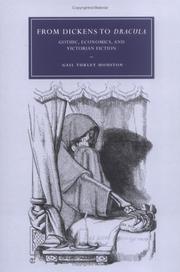
ISBN: 0521846773 0521045797 1107152534 0511125690 0511126247 0511326831 0511484844 1280199245 0511199740 0511125380 9780511126246 9780511125386 0511124104 9780511124105 9780511125690 9780511484841 9781280199240 9786610199242 6610199248 9780521846776 9780521846776 9781107152533 9780511199745 9780511326837 9780521045797 Year: 2005 Publisher: Cambridge, UK New York Cambridge University Press
Abstract | Keywords | Export | Availability | Bookmark
 Loading...
Loading...Choose an application
- Reference Manager
- EndNote
- RefWorks (Direct export to RefWorks)
Ranging from the panoramic novels of Dickens to the horror of Dracula, Gail Turley Houston examines the ways in which the language and imagery of economics, commerce and banking are transformed in Victorian Gothic fiction, and traces literary and uncanny elements in economic writings of the period. Houston shows how banking crises were often linked with ghosts or inexplicable non-human forces and financial panic was figured through Gothic or supernatural means. In Little Dorrit and Villette characters are literally haunted by money, while the unnameable intimations of Dracula and Dr Jekyll and Mr Hyde are represented alongside realist economic concerns. Houston pays particular attention to the term 'panic' as it moved between its double uses as a banking term and a defining emotion in sensational and Gothic fiction. This stimulating interdisciplinary book reveals that the worlds of Victorian economics and Gothic fiction, seemingly separate, actually complemented and enriched each other.
Economics and literature --- Economics in literature. --- Financial crises in literature. --- Stoker, Bram, --- Dracula, Count (Fictitious character). --- English fiction --- Financial crises --- Gothic revival (Literature) --- Horror tales, English --- Money in literature. --- History --- History and criticism. --- Dickens, Charles, --- Knowledge --- Economics. --- Arts and Humanities --- Literature --- Dracula, Count (Fictitious character) --- Crashes, Financial --- Crises, Financial --- Financial crashes --- Financial panics --- Panics (Finance) --- Stock exchange crashes --- Stock market panics --- Crises --- Literature and economics --- Economic aspects --- Dickens, Charles --- Dikensi, Čʻarlz, --- Dickens, Karol, --- Dikens, Charlz, --- Ti-keng-ssu, --- Digengsi, --- Dikkens, Charlz, --- Dikensas, Čarlzas, --- Ṭikkan̲s, Cārls, --- Ṭikkan̲cu, Cārlacu, --- Ṭikkan̲s, Cārlas, --- Диккенс, Чарлз, --- דיקינס, צ׳רלס, --- דיקנס, ַ צ׳רלז --- דיקנס, טשרלס --- דיקנס, צ׳רלז, --- דיקנס, צ׳רלס --- דיקנס, צ׳רלס, --- דיקענס, טש --- דיקענס, טשארלז --- דיקענס, טשארלז, --- דיקענס, טש., --- דיקקענס, טשארלז --- טשרלס, דיקנס --- チャールズ.ディケンズ, --- 狄更斯查尔斯, --- Boz, --- Sparks, Timothy, --- DICKENS (CHARLES), 1812-1870 --- STOKER (BRAM), 1847-1912 --- ROMAN ANGLAIS --- ECONOMIE ET LITTERATURE --- CRISES BOURSIERES --- LITTERATURE D'EPOUVANTE ANGLAISE --- NEO-GOTHIQUE (LITTERATURE) --- ARGENT DANS LA LITTERATURE --- DRACULA --- 19E SIECLE --- HISTOIRE ET CRITIQUE --- GRANDE-BRETAGNE
| Listing 1 - 5 of 5 |
Sort by
|

 Search
Search Feedback
Feedback About UniCat
About UniCat  Help
Help News
News